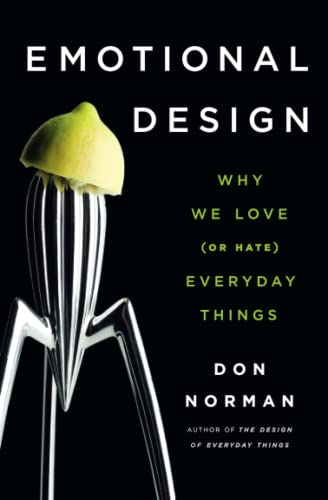The Power of Emotional Design: How Everyday Things Influence Our Affections
Emotional Design: Why We Love explores the powerful relationship between human emotion and design. Written by acclaimed designer and author Don Norman, this book delves into the ways in which design can elicit specific emotions in users, from joy and pleasure to frustration and disappointment. By understanding the emotional impact of design, businesses and designers can create products that resonate with users on a deeper level, fostering loyalty and driving success. Emotional Design is essential reading for anyone interested in the intersection of emotion and design, and the impact it has on our daily lives.


Emotional Design: Why We Love Plot Summary
Emotional design plays a crucial role in how we interact with and experience various products and services. This concept, popularized by Don Norman in his book “Emotional Design: Why We Love (or Hate) Everyday Things,” argues that appealing to users’ emotions can significantly impact their overall experience and perception of a product or service.
In the book, Norman discusses three levels of emotional design: visceral, behavioral, and reflective. The visceral level refers to initial reactions to a product based on its appearance, such as aesthetics and sensory qualities. The behavioral level involves the emotional response during actual use, including how intuitive and functional the product is. Finally, the reflective level involves the memories and emotions associated with using the product over time.
One of the key points Norman makes is that emotional design is not just about making products visually appealing or aesthetically pleasing. Instead, it involves designing experiences that evoke specific emotions and responses in users. By understanding how different design elements can trigger emotional responses, designers can create more engaging and impactful products.
Norman provides numerous examples throughout the book to illustrate the power of emotional design. He discusses how products like Apple’s iPhone and Nest thermostat have successfully incorporated emotional design principles to create products that users love. These products not only function well but also evoke positive emotions and feelings of satisfaction and delight.
The book also delves into the concept of hedonic and utilitarian products. Hedonic products are those that provide pleasure and emotional satisfaction, while utilitarian products focus solely on functionality and practicality. Norman argues that successful products often strike a balance between hedonic and utilitarian qualities, appealing to users on both a functional and emotional level.
One of the key takeaways from “Emotional Design” is the importance of considering users’ emotional responses when designing products. By understanding how design elements can influence emotions, designers can create experiences that are both visually pleasing and emotionally satisfying. This, in turn, can lead to higher user satisfaction, increased loyalty, and greater success in the marketplace.
Overall, “Emotional Design: Why We Love (or Hate) Everyday Things” provides valuable insight into the role of emotions in design and how they can impact user experience. By incorporating emotional design principles into their work, designers can create products that not only meet users’ practical needs but also evoke positive emotions and feelings of connection. As technology continues to evolve, emotional design will become increasingly important in creating products that people truly love.
Emotional Design: Why We Love Key Takeaway
The key takeaway from the book “Emotional Design: Why We Love” by Don Norman is the importance of considering emotions in the design process. Norman argues that successful design goes beyond just functionality and usability, and that designing products and experiences that evoke positive emotions can lead to better user experiences and increased customer satisfaction.
The book explores the three levels of design – visceral, behavioral, and reflective – and how each level contributes to the overall emotional response of users. The visceral level deals with immediate, gut reactions to a design, the behavioral level focuses on how a design functions and can be used, and the reflective level involves the user’s perceptions, memories, and associations with the design.
Norman emphasizes that emotional design is crucial for building strong connections with users and creating products that are not just utilitarian, but also enjoyable and engaging. By understanding and catering to the emotional needs and desires of users, designers can create more meaningful and impactful experiences.
Overall, the key takeaway from “Emotional Design” is that emotions play a central role in how we interact with and perceive the world around us, and incorporating emotional considerations into the design process can lead to more successful and fulfilling outcomes.
Conclusion
In conclusion, “Emotional Design: Why We Love” by Don Norman delves deep into the world of design and human emotion, showcasing how the two intertwine to create a powerful experience for users. Norman effectively explains how emotions play a crucial role in the design of products and how these emotions can greatly impact our perceptions and interactions with the world around us.
The book provides valuable insights into how designers can harness emotions to create more meaningful and impactful designs, ultimately leading to products that users will love. Norman’s writing is engaging and accessible, making the book a must-read for designers, marketers, and anyone interested in understanding the power of emotion in design.
I highly recommend this book to anyone interested in design, psychology, or the intersection of emotions and technology. Readers will appreciate the practical advice and examples provided by Norman, as well as the thought-provoking insights into the way our emotions shape our relationships with the objects and technologies in our lives.
Some other books that readers may enjoy after “Emotional Design: Why We Love” include “The Design of Everyday Things” by Don Norman, “Hooked: How to Build Habit-Forming Products” by Nir Eyal, and “Thinking, Fast and Slow” by Daniel Kahneman. Each of these books provides a unique perspective on the intersection of design, psychology, and human behavior, making them great companion reads to further explore these fascinating topics.

No responses yet